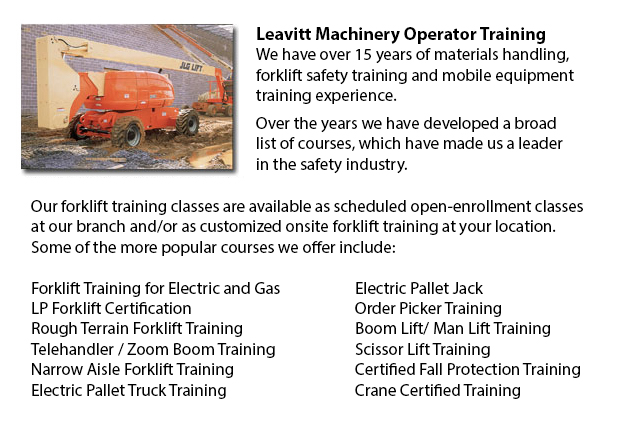
Brampton Aerial Boom Lift Ticket - Aerial lift trucks might be used to accomplish several different tasks executed in hard to reach aerial places. Many of the tasks associated with this style of jack include performing routine maintenance on buildings with elevated ceilings, repairing telephone and utility cables, raising burdensome shelving units, and pruning tree branches. A ladder could also be utilized for many of the aforementioned projects, although aerial lifts provide more safety and stability when properly used.
There are a handful of distinctive designs of aerial lift trucks existing, each being capable of performing slightly unique tasks. Painters will often use a scissor lift platform, which can be utilized to reach the 2nd story of buildings. The scissor aerial lifts use criss-cross braces to stretch and enlarge upwards. There is a table attached to the top of the braces that rises simultaneously as the criss-cross braces raise.
Bucket trucks and cherry pickers are a different variety of aerial lift. They possess a bucket platform on top of a long arm. As this arm unfolds, the attached platform rises. Platform lifts use a pronged arm that rises upwards as the lever is moved. Boom hoists have a hydraulic arm that extends outward and elevates the platform. All of these aerial lift trucks call for special training to operate.
Training programs offered through Occupational Safety & Health Association, known also as OSHA, deal with safety procedures, machine operation, upkeep and inspection and machine cargo capacities. Successful completion of these training courses earns a special certified certificate. Only properly qualified people who have OSHA operating licenses should drive aerial hoists. The Occupational Safety & Health Organization has developed rules to uphold safety and prevent injury when utilizing aerial platform lifts. Common sense rules such as not utilizing this piece of equipment to give rides and ensuring all tires on aerial lift trucks are braced so as to prevent machine tipping are observed within the rules.
Unfortunately, figures reveal that more than 20 aerial hoist operators pass away each year while operating and nearly ten percent of those are commercial painters. The bulk of these incidents were caused by inappropriate tie bracing, hence a few of these may well have been prevented. Operators should ensure that all wheels are locked and braces as a critical security precaution to prevent the instrument from toppling over.
Other rules involve marking the surrounding area of the machine in an observable way to safeguard passers-by and to guarantee they do not come too close to the operating machine. It is imperative to ensure that there are also 10 feet of clearance between any power cables and the aerial hoist. Operators of this machinery are also highly recommended to always have on the appropriate safety harness while up in the air.
-
Brampton Aerial Lift Train the Trainer
Brampton Aerial Lift Train the Trainer - The Aerial Lifts Train the Trainer Certification Program would teach trainers how to efficiently train operators in safe industrial mobile equipment operation. Trainers are provided with in-depth instruction o... More -
Brampton Zoom Boom Training
Brampton Zoom Boom Training - Zoom Boom Training is intended to train operators on variable reach forklifts. The goals of the training are to be able to impart an understanding of the physics of the machinery, and to be able to outline the operator's... More -
Brampton Heavy Equipment Operator Training
Brampton Heavy Equipment Operator Training - Heavy equipment operator training facilities that provide good standards within the industry, providing field performance work and additional machinery training are really sought after training features. S... More -
Narrow Aisle Forklift / Order Picker Training / Electric Pallet Jack / Electric Pallet Truck Training in Brampton
A pallet haul is equipment built in particular for moving pallets of irregular weights and dimensions. They may be used in conjunction with cranes, forklifts and other heavy duty equipment as an appendage piece or to be employed on their own. Pallet... More -
Brampton Overhead Crane Safety Training
Brampton Overhead Crane Safety Training - Overhead crane safety training equips operators with knowledge and skills regarding crane safety measures, accident avoidance, materials handling, and equipment and stock protection. Trainees will learn the k... More -
Brampton Crane Safety Training
Brampton Crane Safety Training - Companies and crane drivers have to know the problems associated to crane safety. Legislation provides rules for the safe maintenance, operation and inspection of lifting machines across North America. Crane Safety co... More -
Brampton Telehandler Training
Brampton Telehandler Training - Telescopic handlers normally known as telehandlers for short, are a really popular piece of heavy construction machinery. They are usually utilized in the construction and agricultural trades. These machines have farth... More -
Brampton Aerial Platform Training
Brampton Aerial Platform Training - Aerial lifts can be used to accomplish many distinctive tasks done in hard to reach aerial spaces. Many of the tasks associated with this style of lift include performing regular upkeep on buildings with high ceili... More

Forklift Certification Brampton
TOLL FREE: 1-888-254-6157
Brampton, Ontario
forkliftcertificationbrampton.com
Email Us
About Us


